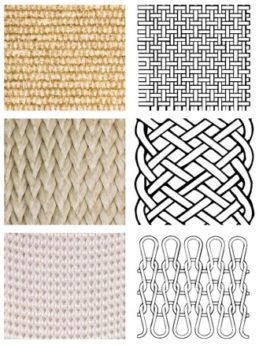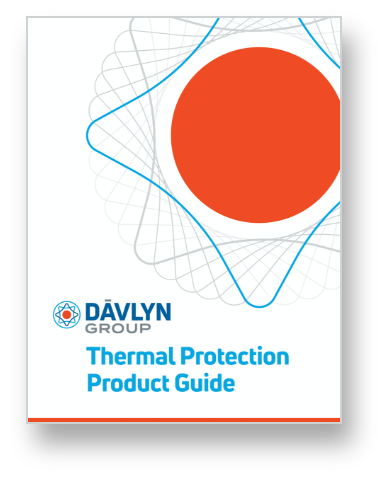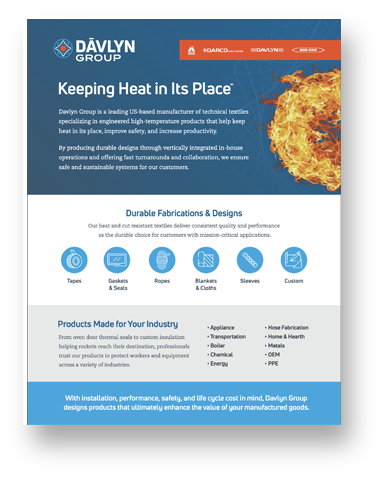When deciding on the best thermal protection solution for your industrial application, there are a number of different factors that must be taken into account. Below, we will explore a few key questions to ask when selecting the right thermal protection solution for you.
When Choosing a thermal insulation material, you will want to answer some key questions, such as:
What material properties are valuable to your industrial application?

Davlyn Group companies work with a wide variety of materials (e.g. fiberglass, silica, ceramic, basalt, meta-aramid, para-aramid) and enhancements (e.g. silicone, graphite, vermiculite, acrylic saturant, foils). This flexibility allows us to provide the optimal custom solution for your specific application. Many times, there is no “one size fits all” solution.
A few questions to ask yourself to find your optimal thermal insulation material are:
- What is the continuous operating temperature? What about maximum or minimum temperatures?
- Will the material be exposed to any chemicals or other environmental factors?
- How important is durability?
- Do you care about the aesthetics of the product?
- What are the desired thermal properties?
- What is the target cost?
What is the intended function of your thermal protection material?
Next, it is important to define the functional requirements. What are your primary objectives?
- Life Safety
- Aesthetics
- Thermal Performance
- Physical Characteristics
- Keeping head in or out?
- Conductive vs. convective vs. radiant?
What material construction is best for your thermal protection application?
Mechanical and thermal properties can vary greatly, depending on the construction, such as:
- Expandability
- Flexibility
- Thermal Conductivity
- Durability
- Aesthetics
Some common material construction offerings are:
Woven Thermal Insulation
Woven products offer a denser construction and are used for products such as tapes, cloths, and blankets. Different weave patterns are available to enhance aesthetics as well as the physical characteristics of the fabrics.
Braided Thermal Insulation
Braided ropes and sleeves have a dense structure with more flexibility than woven or knitted products due to their angled braid design. This characteristic makes braided products an excellent choice for creating thermal gaskets that must accommodate corners or curves.
Knitted Thermal Insulation
Knitted construction is typically the most economical option. It has a less dense and more open structure compared to braided or woven, while still providing excellent heat resistance for many applications. Both circular and flat products can be created by knitting.
How important is ease of installation for your application?
This answer can lead to certain product decisions, including:
- Integrated installation features (hook & loop closure, mechanical fasteners, zippers, ect)
- Coatings or additional layers to improve durability during installation and transport
- Packaging – bulk, boxes, or reels
- Custom kitting
Consider the complete life cycle cost of your intended thermal insulation material
Lastly, you must consider the complete life cycle cost. The thermal protection solution with the lowest total cost of ownership may not always be the most obvious! Key variables that can impact cost include:
- Materials and methods of construction
- Product design complexity
- Packaging
- Scope of work
- Long-term commitments
We are specialists in thermal protection solutions for industrial applications
As you can see, there are many options when it comes to selecting the right material to use for thermal protection. As specialists in thermal protection solutions, our team will work with you to select the highest-performing, cost-effective solution for your heat application. Contact us today!



